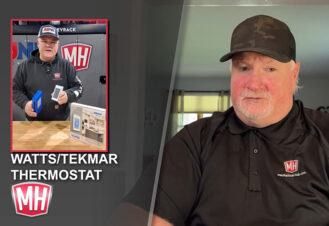By plumbing expert Rich Grimes
In this special article of “In Hot Water”, we will discuss components external of the water heater that can result in hot water complaints. It is everyone’s nature to blame the water heater first but many times these external forces are the culprit.
HOT WATER RECIRCULATION
If a return pump is not functioning, the hot water supply line will go cold until hot water is drawn down the line. If a building has a hot water return system, then they are going to immediately notice lack of hot water at the fixture. They are not used to waiting for hot water and the first complaint is “NO” hot water. So you race over to the site to find out that the heater is working fine and full of hot water…
Another HWR item that can effect the pump operation is an Aquastat. It is designed to cycle the pump on and off based on return water temperature. If it is not functioning properly or the setpoints have been changed, it may be exactly what is causing the hot water problem.
CHECK VALVES
A check valve that is stuck open or closed will create various issues, especially if it is part of the HWR system. A check valve that is stuck closed can overheat and potentially fail the circulator. A check valve that is stuck open can create a cross connection or a point where water can flow in the wrong direction. I have seen quite a few check valves installed in the wrong position. A horizontal swing check has a loose-swinging flapper that will only go to its normally closed position if is mounted horizontally.
Spring-loaded check valves are to be used when mounting vertically and the can also be installed horizontally. The spring assists the check in returning to its normally closed position when there is no flow against it.
GAS SUPPLY
It is important to take a quick check for presence of gas as well as proper supply pressure. Every gas-fired water heater indicates its minimum/maximum supply and manifold pressures on the rating plate. Take the time to verify gas pressure with a manometer, with the heater off and then with the heater on. If the gas pressure falls below the minimum required pressure, the heater can go into flame failure lockout. The pressure or volume issue must be resolved for the water heater to stay on and make hot water.
If you are servicing an Electric water heater, verify that you have supply voltage and secondary voltage.
COMBUSTION AND VENTILATION AIR SUPPLY
Too many boiler rooms and closets are starved for air intake. A gas-fired appliance must have proper air supplied for good combustion. Sometimes the mechanical room becomes a storage area. As the room is filled with various items (many are combustible!) the heater is choked for air. Or the louvers have been covered up by stored items with the same result. The heater cannot ignite and combust correctly and the bad combustion can cause flame failures, sooting and excessive carbon monoxide. Again, the complaint is “NO” hot water that it is not a heater fault, but rather a safety lockout.
VENTING
On many occasions it is the venting system that can create shutdowns. If the vent system is not compatible with the heater it can corrode or condense. If the vent system is undersized, it can cause back-drafting, flame roll-out and improper combustion. If an vent system is oversized, it can cause flame failures due to flame lift-off, flame sense, etc. A barometric damper can alleviate high draft but an oversized stack can still condense due to its lower than normal operating temperature. The location/mounting position of the barometric damper can also affect venting.
It is important to review the vent system to make sure it conforms with the specific appliance category and that it has been installed per manufacturer’s instructions. Improper venting can cause numerous shutdowns but it is a safety issue first and foremost.
HEATER/BOILER CONTROLS
Water heaters and boilers have various safety switches that are designed to shut the unit down if the environment becomes unsafe. For instance, an Intake Air Switch proves that there is enough air for combustion. A Blocked Flue Switch proves that the heater is exhausting properly and there is no vent blockage.
A Flow Switch or Low Water Cut Off prove water flow or water in the vessel. A flow switch also proves circulator operation on forced-circulation boilers.
High Limit controls are designed to shut the unit down in the event of over-heating. A Manual Reset type requires that the user physically push the reset button.
High and Low Gas Pressure Switches insure that the gas pressure is within operating parameters.
It is important to note here that it should never be assumed that the control is bad. If a specific control is not operating, perform diagnostic tests to verify if the part is good. But more importantly, look into external influences like gas pressure, open air intake and proper exhaust, etc. I have seen a few jobs where napkins were sucked up against the air intake pipe by the heater fan motor. They can block off enough air to make the air intake switch blink on and off. This can make it hard to diagnose the switch if some type of blockage really does exist… Take the extra step to verify that connected components are correctly installed, located, and functional.
EXTERNAL CONTROLS
External controls such as a Building Management System (BMS) can enable or disable a unit based on its protocol. Once again, we have “NO” hot water but the heater has had its power disabled by the BMS system.
External Sidewall and Rooftop Venters will have their own pressure switches that must be made before the heater/boiler will receive its power. If the venter does not prove proper operation, the water heater will not have power to operate.
An Aquastat and Flow Switch will function similarly to not switch power to the heater/boiler until its internal switching has been made.
MIXING VALVES
Mixing valves can also create a scenario where the end user is sure that the water heater is not working correctly. The mixing valve can be out of adjustment and most times they are in desperate need of cleaning. A scaled valve cannot sense temperature very well nor adjust to varying flow rates. The simple check is to determine what temperature is the heater storing or producing compared to the mixing valve outlet temperature.
Other issues can arise with mixing valves relative to HWR piping. For the building to maintain a temperature in the HW piping loop, the HWR must pass through the mixing valve in no-demand periods such as overnite. Many piping arrangements that are in the field do not meet the manufacturer’s recommended piping. The HWR balancing can be tricky as one portion of HWR must pass through the mixing valve at the CW supply or internal By-Pass, while another portion of HWR may need to be sent to the vessel for balancing. Too little or too much HWR flow can make the mixing valve malfunction with erratic (low or high) output temperatures.
MOP SINKS/PRE-RINSE STATIONS
Mops sinks and pre-rinse stations are notorious for creating a cross connection of hot and cold water. Many are installed with a three-handle mixing faucet but without inlet check valves on hot and cold supplies. End users will leave the hot and cold valves open which creates an immediate cross connection. A lot of these fixtures will also employ a Vacuum Breaker which can also create a cross connection when it fails.
Check for tempering at these fixtures which can cause low HWR temperatures and wastes vast amounts of gas or electricity.
IMPROPER PIPING/RESTRICTIONS
If a heater’s water or gas piping is incorrect it will have a definite effect on flow and operation. One piping restriction can affect the heater’s operation and output. Reduced gas inlet pipe size and unbalanced water piping are two examples of this.
These are all items that can make an owner point to the heater or boiler and claim “NO” hot water! While you cannot argue that there is no hot water being supplied, you can determine if it is a heater control issue, an external component issue or installation. Any one of these can render your heating system useless and start your phone ringing! There are other environmental conditions that should also be considered such as chemicals, salt and other contaminants that can play into heater operation.




Join the conversation: